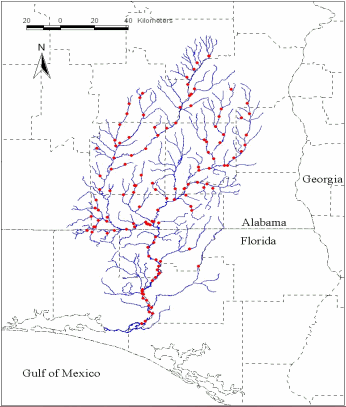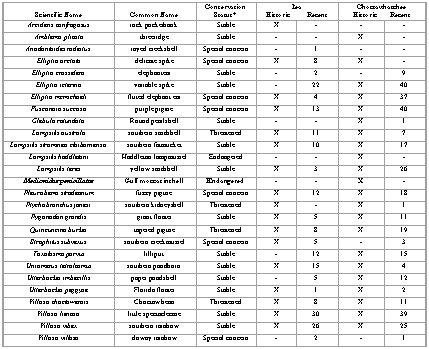|
Freshwater Mussels of the Choctawhatchee
River Drainage in Alabama and Florida
Holly N. Blalock-Herod, Jeffrey J. Herod, and James D. Williams
U.S. Geological Survey, Florida Integrated Science Center
7920 NW 71st Street, Gainesville, FL 32653
Poster presentation to the Southern Division American Fisheries Society Midyear
Meeting Symposium on the "Conservation of Freshwater Nongame Aquatic Fauna
in the Southeast -Challenges for the New Millennium." February 5-6, 2000. Savannah, Georgia.
ABSTRACT
A freshwater mussel survey was conducted at 127 sites in the Choctawhatchee River Drainage in Alabama and Florida between 1998 and 1999. Choctawhatchee River Drainage is comprised of the Choctawhatchee River proper and its main tributary the Pea River. Unionids were found at 104 (82%) sites. Non-indigenous bivalve, Corbicula fluminea, was found at 99 (78%) sites and was the only bivalve present at 13 (10%) sites. Inventory resulted in the presence of 23 species, 11(48%) of which are considered rare. Species considered rare are Anodontiodes radiatus, Elliptio arctata, Elliptio mcmichaeli, Fusconaia succissa, Lampsilis australis, Pleurobema strodeanum, Ptychobranchus jonesi, Quincuncina burkei, Strophitus subvexus, Villosa choctawensis, and Villosa villosa. Villosa lienosa was located at 69 (54%) sites and was the most commonly encountered unionid species in this survey. Anodontoides radiatus, Glebula rotundata, and Ptychobranchus jonesi were each located at only one site each within the drainage basin. Future research will focus on collecting historical museum data, surveying historical sites, and surveying the remaining sites in the Choctawhatchee River.
INTRODUCTION
The Choctawhatchee River Drainage is located in southeastern Alabama and western Florida (Figure 1). The Choctawhatchee River Drainage historically supported a diverse freshwater mussel fauna with 27 species (Athearn 1964, Butler 1994, Clench and Turner 1956, Johnson 1965, 1967, 1969, Williams and Butler 1994). Williams et al. (1993) reports 48% of the mussel species in the Choctawhatchee River Drainage are considered rare. The conservation status for these species was based on historical data collected before 1990 and may not accurately assess the levels of imperilment within the unionid fauna of the Choctawhatchee River Drainage. Additionally, proposed impoundments may further stress the already declining mussel fauna in the Choctawhatchee River system.
Current distributional data for unionids in the Choctawhatchee River Drainage are limited to portions of the Choctawhatchee River, Pea River, and many tributaries in the drainage within Alabama and Florida. The objectives of this project were (1) to provide additional species richness, abundance, and distributional data, for the freshwater mussel fauna of the Choctawhatchee River system, (2) note biological and ecological data from field observations, and (3) discuss potential threats to the unionid fauna of the Choctawhatchee River system.
METHODS
A total of 127 sites were surveyed within the Choctawhatchee River Drainage. Forty sites were near stream reaches that have been identified as locations for possible impoundments by the USDA, Natural Resource Conservation Service (formerly the Soil Conservation Service) and the Forest Service (1993). Alabama and Florida topographic and county road maps were used to select sampling sites throughout the Choctawhatchee River Drainage. Latitudes and longitudes were determined by a Global Positioning System (GPS) unit and/or 7.5-minute topographic maps. Ecological data and potential threats to unionids were recorded at each site.
Qualitative collections of unionids were made by wading, snorkeling, and SCUBA diving. At each site, a minimum of 1.5 person hours was spent collecting mussels. Mussels were identified in the field and returned live. Voucher specimens were brought back to the U.S. Geological Survey, Biological Resources Division, Florida Integrated Science Center (FISC) laboratory in Gainesville, Florida. In the laboratory, specimens that would not be used for genetic analysis were narcotized using pentobarbital sodium, SUCCUMB-6 Gr, fixed in 10% formalin for 2 to 5 days, rinsed in water for 1 to 2 days, and stored in 70% ethanol. A few specimens were placed directly into 95% ethanol for future genetic analysis. Voucher specimens were identified to species. Shell length was measured from the anterior margin to the posterior margin with dial calipers (0.1 mm). Vouchers will be catalogued in the Florida Museum of Natural History.
All data were entered into a Microsoft Access database and analyzed in Microsoft Excel. Distribution maps were generated with Arc View software.
RESULTS
A total of 127 sites were surveyed and resulted in presence and absence data for bivalves (Table 1.). Historically, 27 species were present in the drainage. This project has documented the presence of 23 species. Bivalves were not present at 10 (8%) sites. Total number of sites with Unionids was 104 (82%). Villosa lienosa was located at 69 (54%) sites and was the most commonly encountered unionid species in this survey. Total number of sites with Corbicula fluminea was 99 (78%). The most encountered bivalve species in the Choctawhatchee River Drainage is Corbicula fluminea. Using the Conservation Status in Williams and co-authors (1993), 12 (52%) species of the mussel fauna collected during this survey are considered stable. Eleven (48%) species are considered rare. Rare species are Anodontiodes radiatus, Elliptio arctata, Elliptio mcmichaeli, Fusconaia succissa, Lampsilis australis, Pleurobema strodeanum, Ptychobranchus jonesi, Quincuncina burkei, Strophitus subvexus, Villosa choctawensis, and Villosa villosa. Anodontoides radiatus, Glebula rotundata, and Ptychobranchus jonesi were each located at only one site within the drainage basin. Four species documented from historical data that were not found are Amblema plicata, Arcidens confragosus, Lampsilis haddletoni, and Medionidus penicillatus.
|

